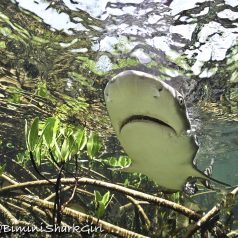
The open ocean and deep coral reefs can be scary places for a fish, even for sharks. As a small shark, there are many things that could eat you in the big blue, from large groupers, moray eels, or even other larger sharks. Before becoming the mighty predators of the sea, small newborn sharks need a strategy to survive long enough to grow into large strong fish that can fend off predators. For some tropical shark species this strategy is hiding out in the roots of shallow water mangroves: trees that grow in coastal saline or brackish water. Mangroves support large populations of prey on which sharks feed and also provide a means of avoidance from large sharks and other marine predators1.
When young bull sharks are still small, they remain in the shallow waters of estuaries and bays, after which they move out to the open ocean and nearby coral reefs. Caribbean reef sharks spend the majority of their younger years in shallow lagoons and close to shallow coral reefs before moving to the deeper reef slopes and pinnacles as adults. Lemon sharks are the best example of a species that spends the first couple of years of its life in the safety of shallow waters with mangroves and seagrass beds.
The shallow waters and mangroves provide a complex habitat structure that keep the young sharks safe from predators, thereby increasing their chances of survival. Species such as lemon sharks, shovelnose rays, blacktip sharks, sicklefin lemon sharks, stingrays, and whiprays are recorded in mangrove habitats. Unpublished data from experts in West Australia suggests that even juvenile and newborn whale sharks spend time in mangrove forests. Juvenile sawfish, one of the ocean’s most critically endangered groups of elasmobranchs, also depend on mangroves for their initial survival. And it is not just sharks. Countless other fishes, crustaceans, molluscs, and even some marine mammals reside in mangrove habitats. For coral reef species, the mangroves have a supporting function. The biomass of commercially interesting fish on coral reefs directly connected to mangroves is more than double compared to reefs with no connecting mangrove. Furthermore, the large diversity of species residing in the mangroves serve as a major food source for sharks.
The small island of Bimini in the Bahamas is probably home to the most studied mangrove system with sharks. Every spring, pregnant lemon shark females arrive at Bimini to give birth to their pups near the mangroves and seagrass beds of the island. The lemon sharks are very attached to their specific place of birth. Research shows that when newborn lemon sharks are displaced from their natural habitat, their so-called homing behavior kicks in, and the small sharks find their way back to the exact mangrove area where they were born. This even applies when the sharks are displaced to nearby islands with similar suitable habitats. Even after they grow older and leave the mangroves to explore other places, when it is time to pup themselves, they always come back to the same spot.
Mangroves are not only essential habitat for sharks and other marine species, but they are invaluable in the race against climate change. Marine vegetation, such as mangroves and seagrass beds, absorb atmospheric carbon up to 100 times faster than terrestrial forests.
Unfortunately, this important nursery habitat is under great threat. Worldwide an estimated 50% of the mangroves has been lost due to coastal development, construction of tourism facilities, and natural distasters. On Bimini, a decline in survival of young lemon sharks has been correlated to developments on the island, causing a 23% decline in first-year survival of the young sharks2.
Lemon sharks also occur in Sint Maarten, where previous developments already removed 80% of the island’s mangroves. Now, due to the passing of hurricane Irma and Maria, another 80% of the mangroves that were left on the island were uprooted and destroyed, damage that was most prominent in the internationally recognized RAMSAR-site “Mullet Pond”. Save Our Sharks initiated a crowdfunding campaign to support the Sint Maarten Nature Foundation in restoring Mullet Pond. With your help, the Nature Foundation can continue cleaning Mullet Pond and replant mangrove seedlings to restore the function of this important site.
Please consider supporting the nature of Sint Maarten by making a donation!
1 For more information about the function of mangroves, you can read the review by Nagelkerke et al. (2008).
2 Jennings et al. (2008) Effects of large-scale anthropogenic development on juvenile lemon shark (Negaprion brevirostris) populations of Bimini, Bahamas. Environmental Biology of Fishes, 83 [4]: pp. 369–377.
Text: Guido Leurs
Photo credit: Jillian Morris.





